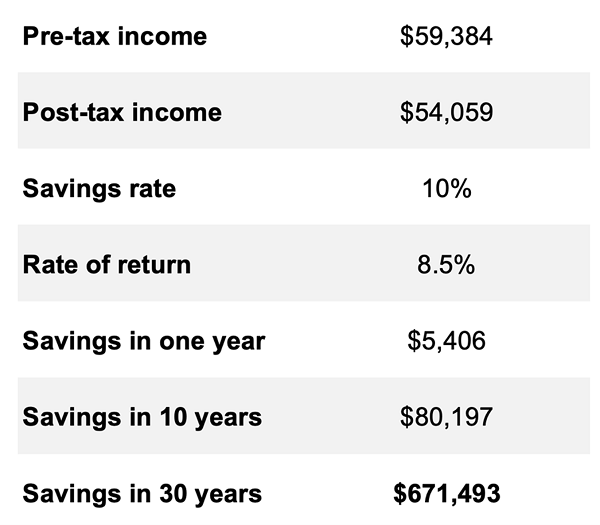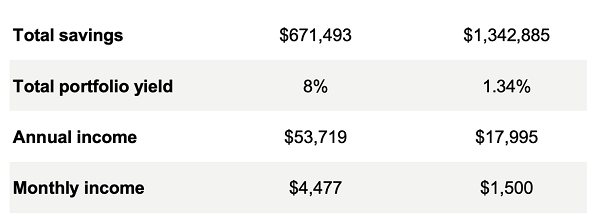If you’re like me, you read (or watch) a lot of personal-finance gurus. And nearly all of them make one critical error when giving advice to folks hoping to save for retirement (or stay retired, if they’re already there).
They put a lot of emphasis on cutting costs—we hear quite a bit about how we should limit small things like your streaming services, for example! Of course, most retirees (save for the very wealthy ones) will tell you that keeping costs reasonable is important.
But what I don’t hear enough from these “gurus” is how to find the high-quality income investments we need to get into retirement faster—and stay there once we arrive.
Gurus Come Around (Sort of) to Our 8% Dividend Plan
So I was surprised when radio host Dave Ramsey recently said he’s comfortable with a retiree withdrawing 8% of their portfolio in retirement, since we use a similar benchmark in my CEF Insider service, whose portfolio yields a tidy 8.7% as I write this.
To see how all this plays out, let’s use a couple scenarios to build two hypothetical retirement portfolios. Then we’ll apply an 8% withdrawal rate to it once our fictitious investors actually do retire.
We’ll base our savings strategy on the average American income of $59,384 a year, and we’ll have two hypothetical savers: one who puts away 20% of their income and another who saves 10%. In both cases, we’ll base our savings scenarios on an 8.5% rate of return, which is around the stock market’s historical annualized total return.
Scenario 1: A Nest Egg Built on 10% Annual Savings

If our first investor saved 10% of their post-tax income under this scenario, they’d have around $80,000 in a decade and about $671,000 in 30 years—not bad at all. And doubling our savings rate obviously doubles those figures.
Scenario 2: Let’s Double Our Savings Rate to 20%

The takeaway is obvious: the more you save per month, the richer you will be.
But let’s not lose track of our goal. We want to replace our wages with passive income. Obviously, the more cash we have, the easier it is to earn passive income. But how much is enough? And how long do you need to work?
The Power of Passive Income
To answer that question, let’s mix things up a bit and compare the 10% saver and 20% savers as they take two different paths once they enter retirement:
The former goes with high-quality closed-end funds (CEFs) yielding 8% or more on average to get their 8% income stream, while the latter sticks to index funds that track the stock market. Our investor then collects their dividends.

As you can see, just by getting an 8% yield (which is easy to come by in CEFs), the CEF investor earns nearly triple the income of the index investor, even though the CEF investor has just half the cash.
Sure, you could argue that this is a pretty extreme case, and I get it. Still, doing what Dave Ramsey suggested for decades is possible with CEFs. Let’s take an example using a CEF called the Columbia Seligman Premium Technology Growth Fund (STK).
STK’s Long History of High Dividends

In orange above, you can see the total profits (including reinvested dividends) the fund has generated since its inception in 2009. In 16 years, STK has maintained payouts at a consistent level (the purple line above) and thrown in some special dividends (the bumps and one trough in that line).
Investors who bought the fund at its IPO back then locked in a 9.3% yield. (STK traded around $20 then, compared to $32 today, which is why its current yield is now 5.8%.) To be sure, that 9.3% figure is much higher than 8%. And this income has come in every year for STK shareholders while their balances in STK have risen in value.

Here we see the portfolio of someone with $1 million in STK. Let’s walk through the numbers.
This investor started with a million dollars. Buying STK at its IPO, when it was $20 per share, would’ve gotten them 50,000 shares. With a $0.4625 per share quarterly dividend, that’s $1.85 per year in dividends per share.
Multiplied by 50,000 shares, that’s $92,500 in income (excluding special dividends) or $7,708 per month, every month, for 16 years. And after those 16 years, our hypothetical STK shareholder would be sitting on nearly $1.6 million in price gains alone, or 50% more than they started with—on top of the 9.3% annual yield.
So yes, Dave Ramsey is right. You can retire on an 8% withdrawal rate—as long as you choose a good CEF with a steady 8% yield. Luckily there are many that fit the bill.
5 Big-Yielding CEFs Kicking Out 100%-Predictable Dividends Every Month
STK is a great fund, but it’s a bit lacking in two ways: 1) Its current yield of 5.8% is too low to build the income stream we want, and 2) It pays dividends quarterly—we want our payouts to roll in every single month!
I know investors love monthly payouts because I hear it from them all the time. And there are plenty of CEFs that do just that— like the 5 monthly dividend CEFs I’m urging investors to buy now. These 5 funds yield a rich 9.2% between them and their payouts come your way every 30 (or 31) days. They’re also cheap now, so we can expect big, “STK-style” price upside from them, too!
All 5 of these reliable monthly payers are waiting to be bought now. Click here and I’ll explain how CEFs can offer big payouts every month, something that’s pretty much unheard of in other corners of the investment world. You’ll also get a free downloadable Special Report revealing the names and tickers of all 5 of these cheap 9.2%-yielding monthly payers.
